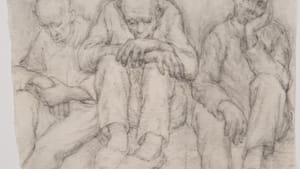Stay in the Loop
BSR publishes on a weekly schedule, with an email newsletter every Wednesday and Thursday morning. There’s no paywall, and subscribing is always free.
The art that survived Auschwitz
The National Liberty Museum presents ‘Forbidden Art’

On the left-hand side of the exhibition, within a wooden frame that is hauntingly reminiscent of a concentration camp’s barracks, there is a projected image of a page taken from an anonymous prisoner’s sketchbook, depicting inmates after their arrival at Auschwitz. It’s one among many riveting pieces of Forbidden Art, a new show at the National Liberty Museum (NLM).
The sketched image shows a man with the Star of David on his right shoulder and a little boy, dressed in a white-and-blue outfit like a sailor’s, being separated from his father. No doubt the boy is destined for the gas chamber. The sketchbook traces the life and death of a prisoner inside the most infamous of all Nazi concentration camps. A few images away, on the same side of the exhibition, also encased in a wooden frame, is a collaboratively created image from a children’s fairytale.
Life and death in Auschwitz
As I stood in front of the haunting masterpieces, studying their tragic beauty, my gut churning at the simultaneous horror and humanity behind each rendition, I wasn’t sure whether to feel joy or sadness.
These scenes on display at the NLM are photographed and projected images of original artistic renderings salvaged from Auschwitz. Even as I beheld the artwork made by Jewish prisoners at a time when any day could be their last, I couldn’t conceive how anyone could tap into creativity in the shadow of a crematorium. And that’s exactly what makes Forbidden Art so evocative.
I went there searching for the renderings of the progression of the life of an Auschwitz prisoner, which I’d heard about during an interview with Lewis Gantman and Joseph Finkelstein, two members of the Auschwitz Birkenau Memorial Foundation (ABMF). ABMF is increasing awareness and raising funds for the effort to preserve the former concentration camp at Auschwitz in the same condition it was on the date of liberation, a project that aligns with NLM’s objective to “bring liberty to life.”
Legacies survive
NLM CEO and cofounder Gwen Borowski said that when ABMF offered to bring Forbidden Art to the museum, it was eager to incorporate the vision into its collection.
Forbidden Art houses one sketch of the progression of the life of a prisoner, but Gantman told me about visiting Auschwitz and seeing a series of eight side-by-side sketches, following a prisoner from the time they arrived at the camp until the Nazis killed them in the crematorium.
These renderings, made without the knowledge of the Nazis, were buried underground in bottles by the artist, in an effort to keep them from being destroyed. After liberation, one of the artist’s fellow inmates returned to the burial site of the artwork and dug it up.

The man who recovered the sketches later became a docent at the Museum at Auschwitz. His daughter is now carrying on his legacy by being a docent herself.
Joseph Finkelstein sees his work with the Auschwitz preservation project as following in his own father’s footsteps. Both of Finkelstein’s parents were survivors, and he sees preserving memory through artifacts as a critical part of his life’s purpose, following his father’s invocation to fight bigotry and hatred. That was part of the impetus behind the collaborative memoir I Choose Life: Two Linked Stories of Holocaust Survival and Rebirth, a narrative written by Finkelstein, his parents, and coauthor Jerry L. Jennings. This memoir intertwines the stories of Sol and Goldie Finkelstein in a poignant testament to the human ability to salvage beauty from pain, something reflected in each and every one of the artistic images included in Forbidden Art.
When liberty is denied
The art included in the exhibition was, as Gantman points out, forbidden for the artists. While Nazis commissioned some art at Auschwitz, forbidden art was made in secrecy, without the approval of the German guards and at grave risk to each artist. “This was art done by the prisoners to soothe their minds, to soothe their bodies, to show what happened,” Gantman explains. It is excruciatingly ironic that art and artifacts were lovingly buried while human beings were denied proper burial after the Nazis murdered them in extermination chambers.
In advance of the exhibition’s opening, I joined Pawel Sawicki of the Auschwitz-Birkenau Memorial Museum and Borowski to discuss the nuanced nature of the exhibition as well as the intention behind bringing Forbidden Art to Philadelphia. As we stood amid projected images of the original artwork, Sawicki said the art displayed was created for a multitude of reasons. There is art created as evidence of the brutality perpetrated at Auschwitz, and art that captures individuals both as they were during imprisonment and as they existed in the days before. There are gestures of gratitude, modes of escape, and even caricatures of German guards, meant to introduce humor in the midst of tragedy.
The creative minds behind the exhibition detailed the thoughtfulness behind the curation and the deliberate decision to choose pieces that represent a cross-section of creativity and artistic expression. It is such a powerful and provocative representation of what can happen when liberty is denied that the NLM renovated a specific space to house the exhibition. These pieces convey not only history, but the lesson that we can all look within ourselves for opportunities to create in the midst of destruction.
What, When, Where
Forbidden Art. Through April 12, 2020 at the National Liberty Museum, 321 Chestnut Street, Philadelphia. (215) 925-2800 or libertymuseum.org.
The National Liberty Museum is a wheelchair-accessible venue.
Sign up for our newsletter
All of the week's new articles, all in one place. Sign up for the free weekly BSR newsletters, and don't miss a conversation.